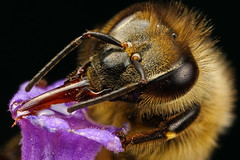Here's another frame of a feeding honeybee that I slowed down by injecting corn syrup into a Lavender flower with a syringe. I knew that the exposure on this setup was going to be a problem -too much contrast between the clear syrup (nothing but a specular highlight zone for the flash) and the flash falloff since there's nothing close in the background to reflect the light from the flash back into the camera. So I set the FEC to -1 2/3 to avoid having to go into manual mode since I was shooting from a lot of different angles and changing the magnification. Hind site being what it is I should have set the flash to manual mode and left the magnification at 3x (where I ended up taking the most frames anyway) -it would have been easier...
The hard part about this scene isn't keeping the critter and the camera steady: She's really into that corn syrup so grabbing the Lavender stem with my left index finger and thumb was easy, and once I had a hold on the flower all I had to do was rest the lens on that same hand and slide ti to get the focus and composition that I wanted. What's tough about a shot like this one is remembering that the area of acceptable focus is parallel to the sensor and thin, so I've got to get it as flat against the bee as I can to make the most of what little depth there is at 3x and F13. For a shot like this one the eyes have to be in focus but so does the entire length of the proboscis. Also anything that's flat, or nearly flat, in the foreground also has to be in focus or your eye will go right to it. Forget focus stacking -although I did slow the honeybee down by giving her something to eat she's still in motion, and I'm actually using my finger and thumb to rotate the flower as she's feeding to keep her looking into the lens and to give me a "magic angle" that will make the most of the depth. It would take some tricky "shotgun photography" to give me more than one frame of the exact same scene and I'd rather spend my time practicing composition and getting the most of a single frame.
At times she was actually standing on my fingers...


7 comments:
Hi, thanks so much for sharing your skills - it is very generous of you but more importantly it makes those secretive macro shooters look very silly :)
I shoot with identical gear to yours except my camera is 450D, and I just have a quick question that I could not find an answer to no matter how hard I tried or where I looked: Compared to the smaller sensors of 40D or 450D, would the shot on a full-frame body have more depth of field if it was later cropped in Photoshop to match the smaller sensor's shot? Thanks!
Due to the larger photosites, and therfore the larger circle of confusion, a full frame sensor should give you more depth that a crop factor sensor at the same manification and Fstop. So the answer is "yes" -the cropped full frame image will have more depth.
hello... hapi blogging... have a nice day! just visiting here....
La vida es esto. Prestémosle atención a los
detalles. Al calorcito humeante del pis, a sacar la basura, a viajar apretados
en colectivo. Si no disfrutamos eso, ¿qué nos queda?
Hi, just wanted to ask some questions. Is MP-65E better than 180L? And are most of ur shots using tripod or handholdable? Thanks:)
BTW never mind my second question, I just read almost ur whole blog an entire night:P
Hey Yudha,
It really depends on what you want to do. If you want to shoot 1X and higher there is no better way than the MPE-65 but the learning curve is steep. But you can't shoot below life size with the MPE (no infinity focus). Due to flash restrictions (needing to get it close to the subject) I think that long focal length lenses like the 180L are better for natural light photography (with flash for fill only). Obviously working distance is a non issue ;)
Post a Comment